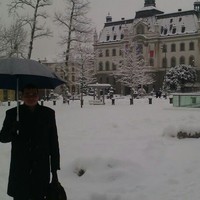
Luis Arce-Plevnik
Luis Arce-Plevnik - Education Profile
Bachelor degree (BSc.) in Industrial Engineering. Universidad Libre, Barranquilla. 2008.
Master degree (MSc. ICD) in International Cooperation for Development. University of Salamanca. 2015-2017
Diploma in Integral Quality Management, Universidad Libre, 2007.
Member of University of Ljubljana Global Network. 2014.
Organic Solar Cells, DTU Denmark Technical University, 2016.
Water Resources Management Policy, Université de Genève, 2016.
Municipal Solid Waste Management in Developing Countries, École Polytechnique Fédérale de Lausanne, 2016.
Graphene and 2-dimensional Materials, University of Manchester, 2016.
Specialization course on International relations of Latin America, Universidad de Salamanca, 2016.
Fundamentals of financial and management accounting, Politecnico di Milano, 2016.
Estimation of measurement uncertainty in chemical analyses, University of Tartu, 2016.
Fundamentals of Global Energy business, University of Colorado, 2016.
Nanotechnology and Nanosensors, Technion - Israel Institute of Technology, 2016.
Sustainable Energy in education, University of Helsinki, 2016.
Design Thinking for Innovation, University of Salamanca, 2016
Energy Policies, University of Tartu, 2016
Digital Marketing, University of Salamanca, 2017
Environmental Auditing in Public Sector, University of Tartu, 2017
Bachelor degree (BSc.) in Industrial Engineering. Universidad Libre, Barranquilla. 2008.
Master degree (MSc. ICD) in International Cooperation for Development. University of Salamanca. 2015-2017
Diploma in Integral Quality Management, Universidad Libre, 2007.
Member of University of Ljubljana Global Network. 2014.
Organic Solar Cells, DTU Denmark Technical University, 2016.
Water Resources Management Policy, Université de Genève, 2016.
Municipal Solid Waste Management in Developing Countries, École Polytechnique Fédérale de Lausanne, 2016.
Graphene and 2-dimensional Materials, University of Manchester, 2016.
Specialization course on International relations of Latin America, Universidad de Salamanca, 2016.
Fundamentals of financial and management accounting, Politecnico di Milano, 2016.
Estimation of measurement uncertainty in chemical analyses, University of Tartu, 2016.
Fundamentals of Global Energy business, University of Colorado, 2016.
Nanotechnology and Nanosensors, Technion - Israel Institute of Technology, 2016.
Sustainable Energy in education, University of Helsinki, 2016.
Design Thinking for Innovation, University of Salamanca, 2016
Energy Policies, University of Tartu, 2016
Digital Marketing, University of Salamanca, 2017
Environmental Auditing in Public Sector, University of Tartu, 2017
less
InterestsView All (28)
Uploads
Papers, Drafts, Notes and Teaching Documents by Luis Arce-Plevnik
When extrapolating the concept of IoT to the automotive industry, we can summarize it into three main branches2. On one side, we have the connectivity between vehicles, which is related to connectivity from one vehicle to two or more vehicles (vehicle-to-vehicle). On the second side we have the connectivity between vehicles with external infrastructure (vehicle-to-infrastructure). And on the third side we have the connectivity with external hardware or external devices (vehicle-to-devices). Taking this concept, a connected car according to Delgrossi, is a vehicle which contains a platform that enables the exchange of information between the car and its surroundings, using local wireless networks, internet or sensors.
When extrapolating the concept of IoT to the automotive industry, we can summarize it into three main branches2. On one side, we have the connectivity between vehicles, which is related to connectivity from one vehicle to two or more vehicles (vehicle-to-vehicle). On the second side we have the connectivity between vehicles with external infrastructure (vehicle-to-infrastructure). And on the third side we have the connectivity with external hardware or external devices (vehicle-to-devices). Taking this concept, a connected car according to Delgrossi, is a vehicle which contains a platform that enables the exchange of information between the car and its surroundings, using local wireless networks, internet or sensors.